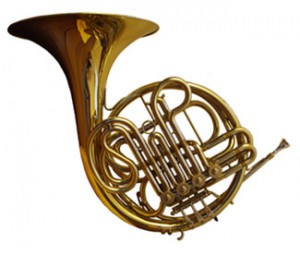Introduction

The French horn, also known as the horn, is a brass instrument that is characterized by its distinctive mellow tone and its flared bell. It is a member of the brass family of instruments, which also includes the trumpet, trombone, and tuba. The French horn is one of the most versatile and expressive instruments in the orchestra and features in a wide range of musical genres, from classical to jazz and film scores.
Although often referred to as the French horn, the instrument is manufactured most commonly today in Germany, featuring rotary valves as opposed to the piston valves found in other brass instruments. Even so, you can still find horns in parts of Europe that utilise piston valves.
History and Development of The French Horn
The modern French horn is a descendant of the hunting horn and trumpet popular in Europe during the Middle Ages. These early horns were made from animal horns and were used by hunters to signal their presence to each other in the forest. Over time, the hunting horn evolved into a more sophisticated instrument with the addition of valves, which allowed the player to change the pitch of the notes.
The instrument as we know it today was developed in the 19th century by French instrument maker, François Périnet. His design featured a series of valves that allowed the player to play a wider range of notes than was possible with the earlier natural horn. The French horn quickly became popular with composers and performers, and it is now a staple of orchestral and chamber music.
Visit our page about the history of the French Horn for more detailed information.
Instrument Description
The French horn is made of brass and has a conical shape, with a flared bell at one end and a mouthpiece at the other. The mouthpiece is typically made of brass or silver and is shaped like a funnel, with a small opening at the top and a wider opening at the bottom. The player produces sound by buzzing their lips into the mouthpiece, which causes the air inside the instrument to vibrate and produce sound waves. One of the distinctive features of the French horn is its use of hand-stopping, a technique in which the player partially or completely covers the bell of the horn with their hand. This changes the pitch of the notes and allows the player to produce a wider range of tones and colors. Hand-stopping is often used to create a muted or veiled sound, which is particularly effective in slow, lyrical passages.
French Horn Tone
As stated in the overview of the brass section, the horn produces a very different and generally less brilliant tone than the heavier brass instruments such as the trumpet or trombone. This is due to it having a conical mouthpiece and bore as opposed to the cylindrical bore and cup-shaped mouthpiece of the trumpet, trombone and tuba.
The primary role of the horn is to work alongside the woodwind section and the heavier brass section. The mechanism of the horn is essentially as follows:
- A tone is produced by the action of the player using his lips (known as the embouchure) which generates wind pressure in the small conical mouthpiece.
- This sets the air within the instrument to vibrate and a tone is produced.
- By varying the embouchure, the player is able to produce the upper partials of the harmonic series based on a fundamental note. Note: this is dependent upon the length of the tube.
To produce notes which do not fall within the basic harmonic series, valves are necessary which enable the addition of extra sections of tube. This in turn varies the pitch. Thus the chromatic scale can be produced by using valves in combination or separately to produce numerous harmonic series.
We have a dedicated page where we discuss the French horn range in much greater detail.
French Horn Transposition
The French horn is a transposing instrument. This means that the notes written on the page don’t correspond to the actual pitches produced by the instrument. The French horn is usually pitched in F or less often in B-flat and the player must transpose the music in line with that. This can be a challenging aspect of playing the French horn because a player has to possess a strong understanding of music theory and be able to think relatively quickly on their feet.
Use and Versatility
It is an extremely versatile instrument and is used in a wide range of musical genres.
- In classical music, the French horn is often used in symphonies, operas, and chamber music. Our series of interviews with Molly Norcross, former Juilliard School student and now Associate Principal Horn with the Cincinnati Symphony Orchestra, offers a great insight into the work of a top opera and symphony hornist.
- The French horn is also used in jazz, where it is often played with a mute to create a distinctive, smoky sound. Giovanni Hoffer is a classically trained hornist (and Wagner tubist) who plays jazz. You can read the exclusive interview he gave us and watch two of his amazing videos in our Wagner Tuba News article “La Scala Wagner Tuba To Gershwin Jazz Horn“.
- The French horn is also used in film scores, where it is often used to create a sense of grandeur and majesty.
Summary
In conclusion, the French horn is an important and versatile instrument with a rich history and a distinctive sound. Its use of hand-stopping and transposition are notable challenges for players but the reward is a wide range of expressive possibilities. Whether in the context of classical music, jazz, or film scores, the French horn is an instrument that continues to capture the imagination of musicians and audiences alike.